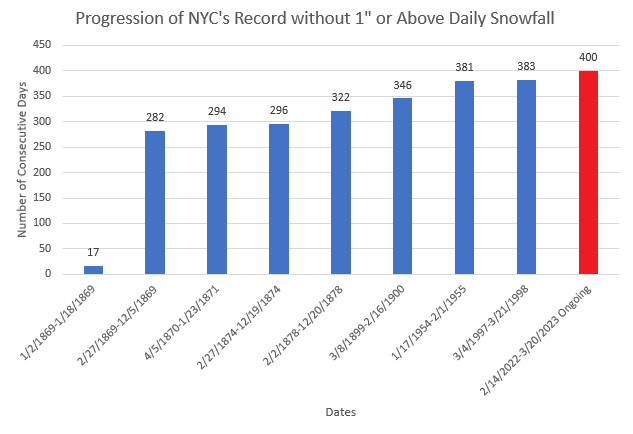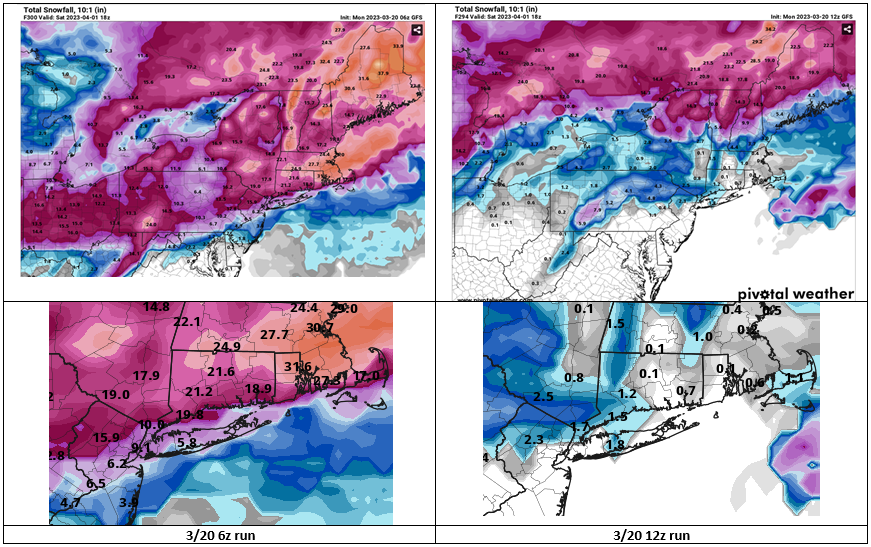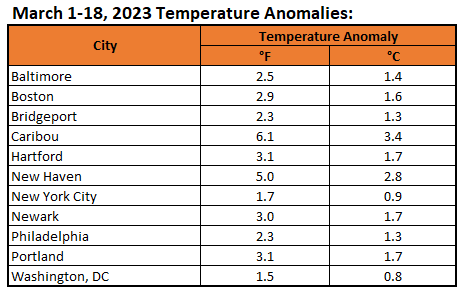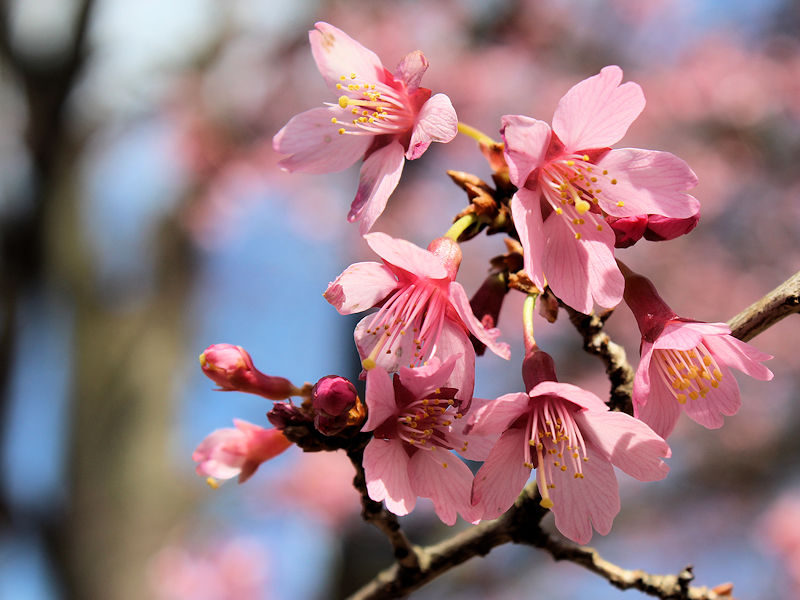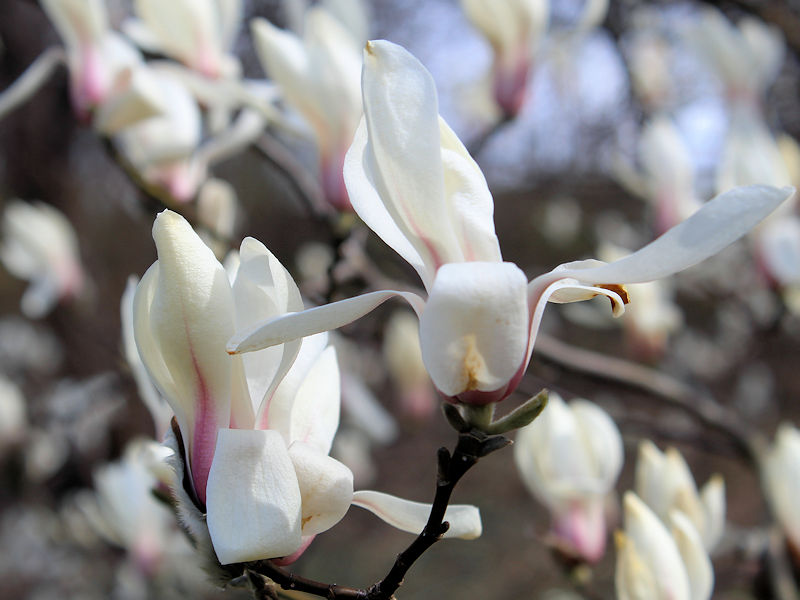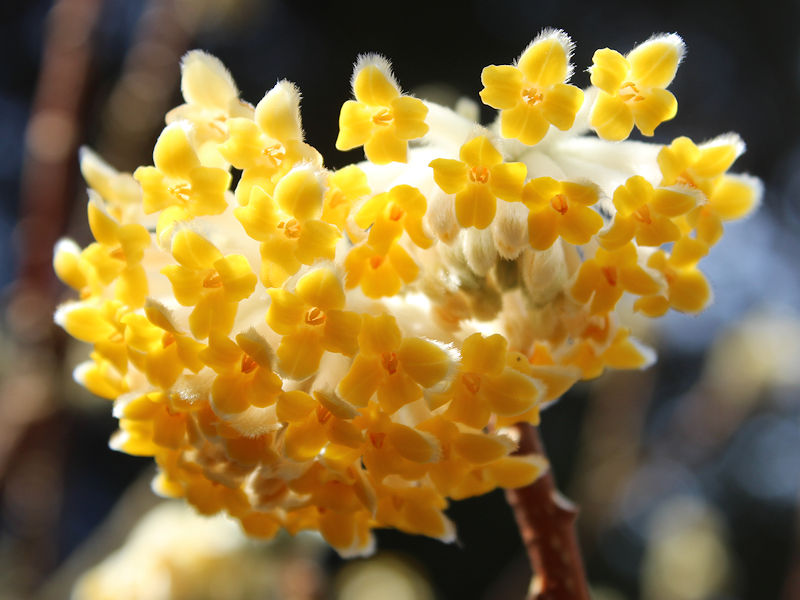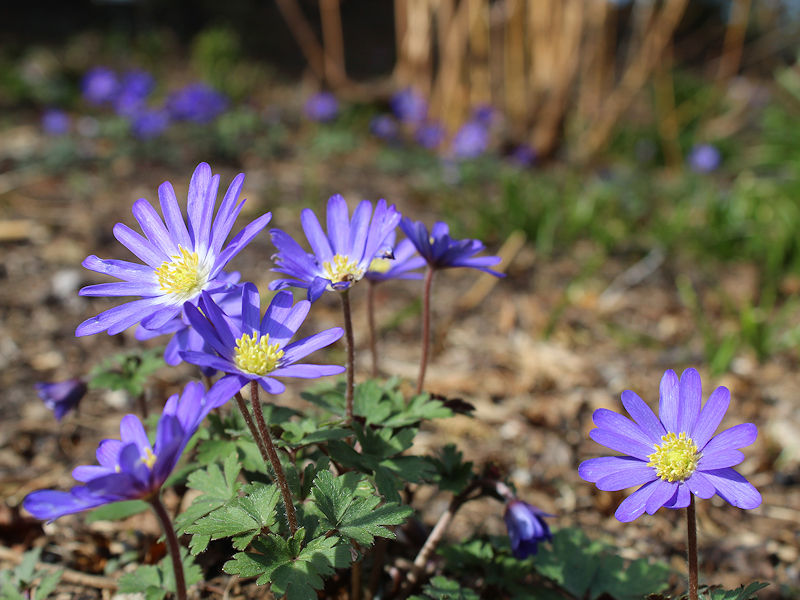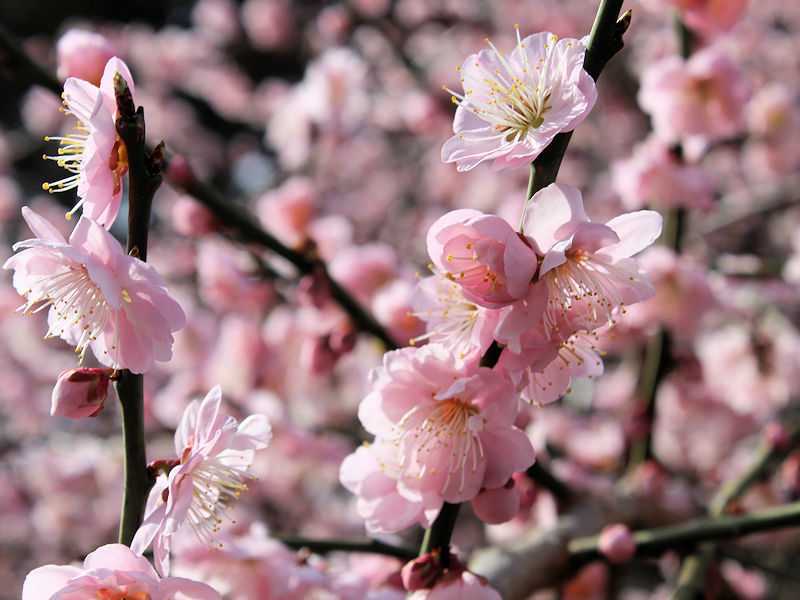-
Posts
22,981 -
Joined
Content Type
Profiles
Blogs
Forums
American Weather
Media Demo
Store
Gallery
Everything posted by donsutherland1
-
Morning thoughts… It will be partly sunny and mild. High temperatures will reach the upper 50s and lower 60s in most of the region. Likely high temperatures around the region include: New York City (Central Park): 59° Newark: 62° Philadelphia: 61° The mild weather will continue through Friday. Normals: New York City: 30-Year: 51.4°; 15-Year: 52.1° Newark: 30-Year: 52.4°; 15-Year: 53.3° Philadelphia: 30-Year: 54.4°; 15-Year: 55.1°
-
Much of this week will feature readings in the 50s and even 60s. Overall, it now appears likely that March will wind up warmer than normal. Historic experience with very low snowfall totals through February argues that a very snowy March or big snowstorm during March or April are unlikely. There were 16 winters that had less than 8" of snowfall through February in New York City. Just two (13%) had a 6" or greater snowstorm during March or April: 1889-1890: 6.0" on March 19th and 1991-1992: 6.2" on March 19th. With just 2.3" snowfall through March 19, New York City is now very likely to finish the season with less than 10" of snow. Since 1869-70, all 10 winters with less than 8.5" of snow through March 19th wound up with less than 10" of seasonal snowfall. New York City is currently on a path that could culminate in its setting a new record for lowest seasonal snowfall. The ENSO Region 1+2 anomaly was +1.4°C and the Region 3.4 anomaly was +0.1°C for the week centered around March 15. For the past six weeks, the ENSO Region 1+2 anomaly has averaged +0.98°C and the ENSO Region 3.4 anomaly has averaged -0.26°C. Neutral ENSO conditions will likely prevail through at least mid-spring. The SOI was -3.45 today. The preliminary Arctic Oscillation (AO) was +0.736 today. On March 18 the MJO was in Phase 1 at an amplitude of 2.510 (RMM). The March 17-adjusted amplitude was 2.593 (RMM). Based on sensitivity analysis applied to the latest guidance, there is an implied 78% probability that New York City will have a warmer than normal March (1991-2020 normal). March will likely finish with a mean temperature near 44.1° (1.3° above normal normal).
-
The storm's heaviest snow extended from eastern PA across central NJ. There were a lot of 16" and 17" amounts in that area with Philadelphia's 19.4" being perhaps the highest figure.
-
New York City's record-breaking stretch without 1" or more daily snowfall has reached 400 days today.
-
-
Yes. Raleigh picked up 10". A photo from North Carolina's State Archives:
-
It seems that ever since the GFS went to the FV3 core, it periodically displays large spring snowfalls in the extended range. Its massive snowstorm for Boston a few days earlier than the one shown for the NYC area is also noted. Currently, the 6z run is on its own with its big snowfall solutions.
-
For NYC, it is probably the last freeze of the season. For the suburbs, it won't be.
-
Southampton had 16.0" in the April 3-4, 1915 snowstorm.
-
Morning thoughts… It will be mostly sunny and milder. High temperatures will reach the lower 50s in most of the region. Likely high temperatures around the region include: New York City (Central Park): 51° Newark: 54° Philadelphia: 53° The mild weather will continue through Friday.
-
-
Despite abundant sunshine, today was an unseasonably cool day. Like so often since December, the cold shot will be fleeting. Temperatures will rebound into the 50s tomorrow. Afterward, much the week will feature readings in the 50s and even 60s. Overall, it now appears likely that March will wind up warmer than normal. Historic experience with very low snowfall totals through February argues that a very snowy March or big snowstorm during March or April are unlikely. There were 16 winters that had less than 8" of snowfall through February in New York City. Just two (13%) had a 6" or greater snowstorm during March or April: 1889-1890: 6.0" on March 19th and 1991-1992: 6.2" on March 19th. With just 2.3" snowfall through March 19, New York City is now very likely to finish the season with less than 10" of snow. Since 1869-70, all 10 winters with less than 8.5" of snow through March 19th wound up with less than 10" of seasonal snowfall. New York City is currently on a path that could culminate in its setting a new record for lowest seasonal snowfall. The ENSO Region 1+2 anomaly was +1.5°C and the Region 3.4 anomaly was -0.1°C for the week centered around March 8. For the past six weeks, the ENSO Region 1+2 anomaly has averaged +0.76°C and the ENSO Region 3.4 anomaly has averaged -0.35°C. Neutral ENSO conditions will likely prevail through at least mid-spring. The SOI was -7.66 today. The preliminary Arctic Oscillation (AO) was -0.087 today. On March 17 the MJO was in Phase 1 at an amplitude of 2.594 (RMM). The March 16-adjusted amplitude was 2.770 (RMM). Based on sensitivity analysis applied to the latest guidance, there is an implied 75% probability that New York City will have a warmer than normal March (1991-2020 normal). March will likely finish with a mean temperature near 43.9° (1.1° above normal normal).
-
First, corrections for 1956, as I took the numbers from the wrong column: March 16-17: 4.2" March 18-19: 12.4" In terms of snowcover, March 1967 easily had more than 1956 at Patchogue (2 N): 1956: Peak snowcover: 10"; Average monthly snowcover: 0.6"; Biggest snowfall: 12.4", March 18-19 1967: Peak snowcover: 15"; Average monthly snowcover: 2.5"; Biggest snowfall: 16.1", March 22-23
-
Through March 18th, 2023 is off the the warmest start on record for New York City. Four of the top five cases and seven of the top ten cases have occurred since 2000. All ten have occurred since 1990. New York City has had a mature urban footprint since the 1950s. Records go back to 1869.
-
Morning thoughts… It will be mostly sunny, windy and unseasonably cool. High temperatures will reach the lower 50s in most of the region. Likely high temperatures around the region include: New York City (Central Park): 41° Newark: 44° Philadelphia: 44° Milder air will return tomorrow and remain in place through the remainder of the week. Normals: New York City: 30-Year: 50.7°; 15-Year: 51.4° Newark: 30-Year: 51.7°; 15-Year: 52.6° Philadelphia: 30-Year: 53.7°; 15-Year: 54.3
-
Colder air is moving into the region. Tomorrow will be unseasonably cold with high temperatures reaching the upper 30s and lower 40s. A gusty wind will add to the chill. However, the parting shot of what had been an extraordinarily mild winter will be fleeting. Temperatures will rebound into the 50s on Monday with much the week featuring readings in the 50s and even 60s. No potential snowstorms appear likely through at least the end of next week. New York City is currently on a path that could culminate in its setting a new record for lowest seasonal snowfall. Overall, it now appears that March will wind up at least somewhat warmer than normal. It is also possible that New York City could see its last freeze of the season on tomorrow morning or Monday morning. Historic experience with very low snowfall totals through February argues that a very snowy March or big snowstorm during March or April are unlikely. There were 16 winters that had less than 8" of snowfall through February in New York City. Just two (13%) had a 6" or greater snowstorm during March or April: 1889-1890: 6.0" on March 19th and 1991-1992: 6.2" on March 19th. With just 2.3" snowfall through March 16, New York City has a high probability of finishing with less than 10" of snow. Since 1869-70, 88% of winters with less than 8" of snow through March 16 wound up with less than 10" seasonal snowfall. The highest seasonal amount in such cases occurred in 1991-1992 when 12.6" of snow was measured. By March 19th, all 10 winters with less than 8.5" of snow wound up with less than 10" of seasonal snowfall. The ENSO Region 1+2 anomaly was +1.5°C and the Region 3.4 anomaly was -0.1°C for the week centered around March 8. For the past six weeks, the ENSO Region 1+2 anomaly has averaged +0.76°C and the ENSO Region 3.4 anomaly has averaged -0.35°C. Neutral ENSO conditions will likely prevail through at least mid-spring. The SOI was -4.79 today. The preliminary Arctic Oscillation (AO) was -0.082 today. On March 16 the MJO was in Phase 1 at an amplitude of 2.784 (RMM). The March 15-adjusted amplitude was 3.114 (RMM). Based on sensitivity analysis applied to the latest guidance, there is an implied 67% probability that New York City will have a warmer than normal March (1991-2020 normal). March will likely finish with a mean temperature near 43.6° (0.8° above normal normal).
-
Nature has now made an irreversible commitment to spring at the New York Botanical Garden. Below are some photos from this afternoon:
-
The question is whether the ad revenue begins to dry up when his repeated forecasting debacles become evident. Already, some meteorologists, including former Accuweather colleagues, are starting to call out his failures on Social Media.
-
Pursuing clicks at the expense of one's credibility is not a good trade-off. The costs far exceed the short-term benefits once one's credibility is lost. Loss of credibility is damaging to one's professional reputation.
-
Unfortunately, ISP’s period of record doesn’t go back to 1956. Data from Patchogue (2 N) is available: March 16-17: 4.2" March 18-19: 12.4"
-
There were back-to-back storms on March 16-17 and March 18-19. It was an epic finish to the winter.
-
Morning thoughts… Clouds will give way to bright sunshine. High temperatures will reach the lower 50s in most of the region. Likely high temperatures around the region include: New York City (Central Park): 52° Newark: 54° Philadelphia: 53° Tomorrow will be unseasonably cool, but milder air will return on Monday and remain in place through the remainder of the week. Normals: New York City: 30-Year: 50.3°; 15-Year: 51.0° Newark: 30-Year: 51.3°; 15-Year: 52.3° Philadelphia: 30-Year: 53.3°; 15-Year: 54.0°
-
Early clouds will yield to sunshine tomorrow. It will turn breezy and a brief shot of cold will overspread the region for Sunday. Afterward, temperatures will rebound. Model support has continued to increase for a sustained turn toward milder weather next week. Some uncertainty still exists, but the overall probability that March could finish near or somewhat warmer than normal has increased dramatically in recent days. No potential snowstorms appear likely through at least the end of next week. New York City is currently on a path that could culminate in its setting a new low seasonal snowfall record. Historic experience with very low snowfall totals through February argues that a very snowy March or big snowstorm during March or April are unlikely. There were 16 winters that had less than 8" of snowfall through February in New York City. Just two (13%) had a 6" or greater snowstorm during March or April: 1889-1890: 6.0" on March 19th and 1991-1992: 6.2" on March 19th. With just 2.3" snowfall through March 16, New York City has a high probability of finishing with less than 10" of snow. Since 1869-70, 88% of winters with less than 8" of snow through March 16 wound up with less than 10" seasonal snowfall. The highest seasonal amount in such cases occurred in 1991-1992 when 12.6" of snow was measured. By March 19th, all 10 winters with less than 8.5" of snow wound up with less than 10" of seasonal snowfall. The ENSO Region 1+2 anomaly was +1.5°C and the Region 3.4 anomaly was -0.1°C for the week centered around March 8. For the past six weeks, the ENSO Region 1+2 anomaly has averaged +0.76°C and the ENSO Region 3.4 anomaly has averaged -0.35°C. Neutral ENSO conditions will likely prevail through at least mid-spring. The SOI was -4.64 today. The preliminary Arctic Oscillation (AO) was -0.087 today. On March 15 the MJO was in Phase 1 at an amplitude of 3.125 (RMM). The March 14-adjusted amplitude was 3.532 (RMM). Based on sensitivity analysis applied to the latest guidance, there is an implied 60% probability that New York City will have a warmer than normal March (1991-2020 normal). March will likely finish with a mean temperature near 43.3° (0.5° above normal normal).
-
He was once a very good forecaster. Unfortunately, he failed to adapt his framework and approach to address the forecasting realities of today's warmer world. The reduced pool of cold air coverage, higher incidence of pattern-influencing marine heatwaves, greater atmospheric moisture content, the rise of quasi-resonant amplification, etc. have fundamentally altered the forecasting context. What worked well in the 1990s or even very early 2000s doesn't work so well today. Analogs constructed from the earlier climate regime have lost relevance. Objectivity is a prerequisite for recognizing the shift that has taken place and its implications. Flexibility is necessary to revise one's forecasting framework and approach. Denial or refusal to accept the changes that have occurred and rigidity in forecasting frameworks and approaches assure one's inability to adapt when the change takes place, as it has. In the end, forecasting greatness is determined over time and is best distinguished in the capacity of a forecaster to successfully adapt to change. A forecaster who makes the successful transition from one forecasting context to another one while continuing to deliver sound forecasts is a great forecaster.
-
FYI, the Thread-ex error that showed NYC had a record high minimum temperature of 87° on July 2 has now been fixed. The correct value (82°, 1901) is now listed.





